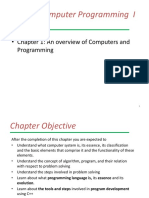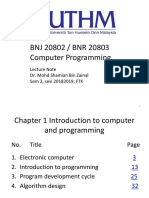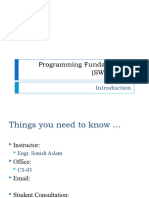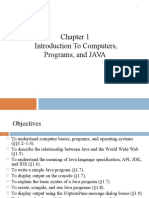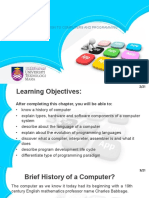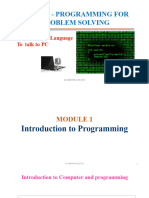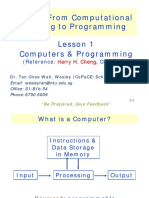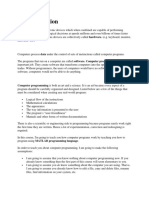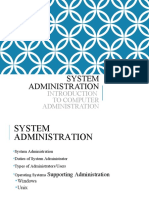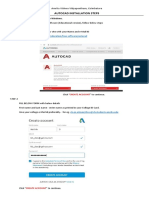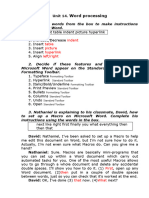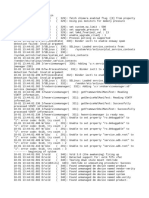CSC 101
INTRODUCTION TO
COMPUTER SCIENCE
AY 2014-2015 (Term 2)
�Grading System
Exam
Laboratory Exercise/Quiz
HW/SW
Attendance
Passing Rate:
No Removal Exam
Main References:
60 %
25
10
5
60%
JAVATM Programming: From Problem Analysis to Program Design by D. S. Malik
JAVATM How to Program, 7th ed by Deitel
�LECTURE 1
INTRODUCTION TO COMPUTER
SYSTEMS
�Lecture Outline
What is a computer?
Hardware
and Software
Components of a Computer System
Starting a Program
Networks
Language of a Computer
Evolution of Computer Language
Programming
Programming Methodologies
�What is a computer?
a general purpose device that can be
programmed to carry out a set of arithmetic
or logical operations automatically
a complex system consisting of both
hardware and software components
Variations:
embedded computers
calculator, ATM, printer, videogame console
personal computer (aka desktop and home
computer), laptop, portable, notebook
computer
PDA
Mainframe or Supercomputer
�Hardware vs Software
Hardware
Software
collection of instructions that
enables a user to interact with the
Devices that are required to store
computer
a program that enables a
and execute (or run) the
Definition
software.
computer to perform a specific
task, as opposed to the physical
components of the system
Types
Input, storage, processing,
control, and output devices.
Examples
System software, Utility software,
and Application software.
CD-ROM, monitor, printer, video
card, scanners , label makers,
routers , and modems.
Operating systems, drivers, Adobe
Acrobat, Internet Explorer ,
Microsoft Word , Microsoft Excel
�Components of a Computer System
Computer
I/O
CPU
System
Bus
Memory
�Components of a Computer System
CPU
Computer
I/O
CPU
System
Bus
Registers
ALU
Internal
Bus
Memory
Control
Unit
�Components of a Computer System
Memory
Main/Primary
Secondary
closely connected to the
processor.
stored data are quickly and
easily changed.
holds the programs and data
that the processor is actively
working with.
interacts with the processor
millions of times per second.
needs constant electric power
to keep its information.
connected to main memory
through the bus and a
controller.
stored data are easily changed,
but changes are slow
compared to main memory.
used for long-term storage of
programs and data.
before data and programs can
be used, they must be copied
from secondary memory into
main memory.
does not need electric power
to keep its information.
�Starting a Program
1.
The user asks to run an application.
2.
The OS determines the name of the application.
3.
The OS finds the files on the hard disk where the application and its data are
stored.
4.
The OS finds an unused section of main memory that is large enough for the
application.
5.
The OS makes a copy of the application and its data in that section of main
memory.
6.
The OS sets up resources for the application.
7.
Finally, the OS starts the application running.
�Computer Networks
Network
consists of two or more computers connected so that they can
exchange data and programs
through network interface card
�Computer Networks
Internet
a global system of interconnected computer networks that use the
standard Internet protocol suite (TCP/IP) to link several billion devices
worldwide
carries an extremely large number of network services, including the
World Wide Web, electronic mail, Internet phone, audio, video and file
transfer services
World Wide Web
a global set of documents, images and other resources, logically
interrelated by hyperlinks
�Language of a Computer
Electrical Signals
Analog
continuous waveforms used to represent things, such as sound
Digital
represent information with a sequence of 0s and 1s
more reliable carriers of information than analog signals and can be copied from
one device to another with exact precision
Machine Language is digital.
�Language of a Computer
binary digit or bit
digit 0 or 1
binary code or binary number
sequence of 0s and 1s
byte
8 bits
American Standard Code for
Information Interchange (ASCII)
most commonly used
encoding scheme on personal
computers
�Evolution of Programming Languages
Machine Language
provides program instructions in bits
even though most computers perform the same kinds of operations, the designers of different
CPUs sometimes choose different sets of binary codes to perform those operations
Ex: user wants to use the equation c = a + b
a
010001
load
100100
010010
addition
100101
010011
store
100010
100100 010001
100101 010010
100010 010011
� Assembly Language
developed to make the programmers job easier
an instruction is an easy-to-remember form called a mnemonic
LOAD a
ADD b
STOR c
�High-Level Language
closer to spoken languages
Basic, FORTRAN, COBOL, Pascal, C, C++, and Java
Ex:
c = a + b;
� Processing a JAVA
program
�Programming
a process of problem solving
1.
analyzing a problem
2.
outlining the problem requirements
3.
designing steps (algorithm)
Algorithm
a step-by-step problem-solving process in which a solution is arrived at in a
finite amount of time
�programming process
�Ex: Design an algorithm to find the perimeter and area of a
rectangle
1. Get the length of the rectangle.
2. Get the width of the rectangle.
3. Find the perimeter using the following equation:
perimeter = 2*(length + width)
4. Find the area using the following equation:
area = length*width
�Programming Methodologies
Structured Programming
problem
is divided into smaller subproblems then each subproblem
is analyzed and a solution for the subproblem is obtained. The
solutions to all the subproblems are then combined to solve the
overall problem
also
known as top-down design, bottom-up design, stepwise
refinement, and modular programming
�Programming Methodologies
Object-Oriented Programming
first
step in the problem-solving process is to identify the
components called objects, which form the basis of the solution,
and to determine how these objects interact with one another
�Review
True or False:
1.
Assembly language is the language that uses mnemonics for its instructions.
2.
The arithmetic operations are performed inside CPU and, if an error is found, it outputs the
logical errors.
3.
A Java compiler is a program that translates a Java program into bytecode.
4.
Bytecode is the machine language of the JVM.
5.
The CPU stands for command performing unit.
6.
RAM stands for readily available memory.
7.
A program written in a high-level programming language is called a source program.
8.
The operating system is the first program loaded into the computer when the power is turned
on.
9.
The first step in the problem-solving process is to analyze the problem.
�References
JAVATM Programming: From Problem Analysis to Program Design by D. S. Malik
JAVATM How to Program, 7th ed by Deitel
Computer. http://www.computerhope.com/jargon/c/computer.htm
Top 10 Most Popular Programming Languages. http://www.english4it.com/reading/40
Introduction to Computer Science using Java.
http://chortle.ccsu.edu/CS151/cs151java.html
Introduction to Computer Science.
http://en.wikiversity.org/wiki/Introduction_to_Computer_Science
Hardware vs Software. http://www.diffen.com/difference/Hardware_vs_Software

